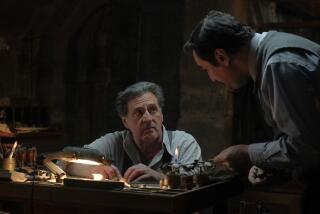Revisiting Jean-Luc Godard’s ‘Le Petit Soldat’
Jean-Luc Godard made his second feature film, “Le Petit Soldat,” in 1960, but it was banned until 1963 because of its tough look at the then-current French-Algerian conflict and unblinking portrayal of torture.
Opening Friday at the Nuart in a new 35-millimeter print with fresh translation and subtitles, the often-overlooked film provides a lens through which to view the French director’s unparalleled streak of provocation and productivity in the 1960s, as well as a startlingly contemporary-feeling counterpoint to recent politically tinged war films such as “Zero Dark Thirty.”
“The film should bear witness to the period,” Godard said in an interview with the publication Cahiers du Cinéma in 1962, the year Algeria gained its independence. “Politics are talked about in it, but it has no political bias.”
PHOTOS: Behind-the-scenes Classic Hollywood
The film — the title translates as “The Little Soldier” — follows a French army deserter turned photojournalist and political operative named Bruno Forestier (Michel Subor) in Geneva as he meets a young woman, Veronica Dreyer (Anna Karina). Caught between agents working for both French and Algerian forces, he finds himself ensnared in a plot to assassinate an anti-French activist.
Captured by Algerian agents, Bruno is manacled in a bathroom, burned, dunked in a bathtub and has his head covered in a shirt that is doused with water. Then he is given a series of electric shocks. He escapes and tries to make his way back to Veronica.
The sequence is markedly different from the recently controversial portrayal of torture and interrogation in “Zero Dark Thirty.” Richard Brody, who chronicled the making of “Le Petit Soldat” in his 2008 biography of Godard, “Everything Is Cinema,” recently wrote for the New Yorker: “There’s more breadth and depth — more of a sense of history at large, of the intrinsic and profound horror of the practice and the experience of torture, and of the moral issues involved in political action — in that thirteen-minute sequence than in the whole of ‘Zero Dark Thirty.’”
The film also marks the first appearance of Karina in a Godard movie; the actress would become his wife in 1961. Their electrifying connection and stormy off-screen relationship would play out across numerous films, from playful romance to hurtful recriminations to mournful regret.
PHOTOS: Hollywood Backlot moments
In “Le Petit Soldat,” it is easy to feel Godard’s attention and affection being drawn to Karina; he not yet 30 and she not quite 20. Her enchanting mix of sweet and sultry, an enigmatically seductive wholesomeness, is what makes her an enduring figure, frequently mentioned as a style inspiration and crush object. By the time they made their last film together, “Made in U.S.A.” in 1966, the couple was already divorced.
This new release should earn back “Le Petit Soldat” its rightful place as an early but fully formed work in Godard’s staggering jumble of a filmography. With its mixture of politics and romance, intertwining broader social and historical issues with personal specifics, “Le Petit Soldat” is both immediate and circumspect.
“I spoke of what concerned me, a Parisian in 1960, belonging to no party,” Godard said at the time. “And what concerned me was the problem of war and its moral repercussions. So I showed a man who poses himself a lot of problems. He can’t resolve them, but to pose them, even confusedly, is already an attempt at a solution.”
PHOTOS AND MORE
Roger Ebert: Career in pictures
ENVELOPE: The latest awards buzz
PHOTOS: Greatest box office flops
More to Read
Only good movies
Get the Indie Focus newsletter, Mark Olsen's weekly guide to the world of cinema.
You may occasionally receive promotional content from the Los Angeles Times.







